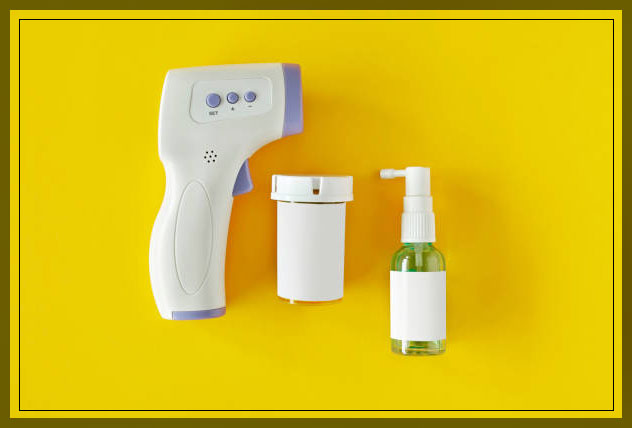
Today, a digital thermometer is an important part of a medical healthcare facility.
A thermometer is a medical device that helps to measure and display body temperature.
With the help of this measurement, doctors can diagnose when a patient has a fever, which can be a symptom of different illnesses or infections.
There are different ways to take the temperature of the patients, and different types of digital thermometers you can use.
With the help of a digital thermometer, you can get accurate results while measuring the temperature.
When buying a digital thermometer, one should consider, the type of thermometer, accuracy, speed, sustainability, and a number of things before buying them.
Keep on reading to learn more about digital thermometers.
Choosing a Digital Thermometer
There are different factors you should consider when buying a digital thermometer.
These may include your budget, application, type of digital thermometers, patient comfort, hygiene, and safety conditions.
Measurement Points
In general cases, a number of people take temperature measurements anally, orally, axillary, by ear, or your forehead like a forehead thermometer.
However, depending on each case, one point of measurement you choose can help children and adults.
It is important to note that some thermometers are suitable for specific applications like pediatrics.
Type of Thermometer
There are different types of medical thermometers, which experts divide into two main groups.

These are:
- classic analog glass model
- electronic models
Moreover, electronic models tend to either be probe or infrared.
Comfort
It is important to note that thermometers can have flexible or rigid tips.
While some are single-use or disposable to avoid contamination among patients, in pediatrics, the tips may have a shape like a pacifier.
This helps to facilitate the use of young patients and family members. However, non-contact thermometers offer an increase in comfort.
Health and Safety Measures
Depending on the type and application, medical thermometers need to comply with certain health and safety measures.
For instance, electronic non-contact infrared thermometers require no cleaning after use.
Therefore they are safer for patients than analog ones.
Learn more about Sterilization and Disinfection here.
Technical Characteristics to Consider when buying Digital Thermometer
When choosing a medical thermometer, there are different technical features one should consider, like display speed, accuracy, range, and unit of measurement.
Let’s discuss them as follows:
Ease and Speed of Use
Some electronic models offer a fast response rate time.
Moreover, they also have a digital display for simple and concise viewing. It is important to note that infrared thermometers have an almost instantaneous reading speed.
Accuracy and Reliability
These two characteristics depend on the temperature measuring point they use and compliance with the instructions of the device.

While anal measurements remain the most reliable of temperature accuracy.
Versatility
Some thermometers are versatile and you can use them for a number of applications through the use of different tips.
Temperature Range
Temperature measuring ranges can vary depending on the model.
Moreover, they generally are between 35°C and 42°C.
Units of Measurement
It is important to note that thermometers help to indicate the body temperature in the following units:
- Fahrenheit (°F)
- degrees Celsius (°C)
Though in the United States, the temperature is measured in Fahrenheit, and in most countries in Celsius.
Difference between Measurement Points
Each measurement point has its advantages and disadvantages.
You can take the temperature in different ways like anally, orally, axillary, by the forehead, or by ear.
Let’s discuss each as follows:
Anal
Use: The probe of the analog or electric thermometer is inserted into the rectum.
This technique is mostly used for infants or very young children.
Advantages: This is the most reliable and accurate method as it gives the central body temperature.
Disadvantages: Taking temperature anally can be uncomfortable and it requires the healthcare professional to position the child correctly for safety reasons.
And you will have to disinfect the thermometer each time they use it.
Oral
Use: You will have the place the probe of the analog or electric thermometer under the tongue of the patient.
Moreover, the patient should keep his or her mouth closed and breathe through the nose, while taking the measurement.
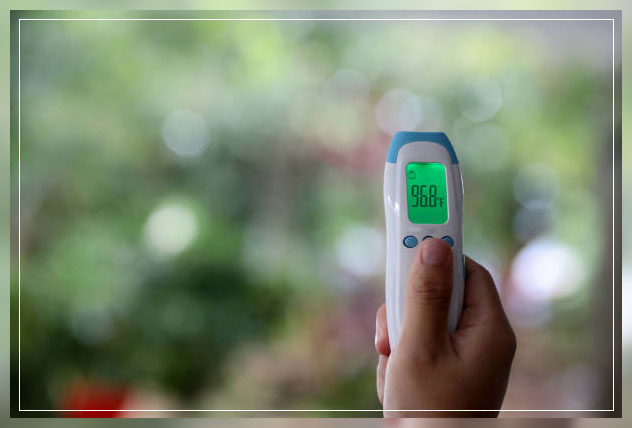
Advantages: This method is easy for patients while not for infants and young children.
Disadvantages: Though this technique is less precise than the rectal routine, the measurement remains reliable as long as the patients keep their mouths closed.
Furthermore, it is important to wait 15 minutes after drinking or eating before the healthcare professional takes the temperature.
Make sure to clean the thermometer after each use.
Forehead
Use: You can take the measurement with a non-contact electronic infrared thermometer or via a strip that you will place directly on the forehead of the patient.
Advantages: Taking measurements via forehead is an easy method.
Also, it is practical and does not cause any discomfort to the patients. However, in the case of infrared thermometers, it is hygienic as there is no contact.
Disadvantages: The measurement via the forehead is not as precise as the one you take through the rectum or ear.
Other Measurement Points
Other measurement points are:
Ear
Use: For this, you can use an electronic ear thermometer. To use this, you will need to insert the probe into the ear canal.
However, you can also use disposable tips after using them or during sports outdoors.
Advantages: This is a quick and easy method to use.
Disadvantages: Though this technique is reliable,e however, the potential presence of the buildup of wax can distort results.
Moreover, it is also important to follow the instructions for use so as not to damage the ear of the patient.
Axillary
Use: To use this, you will have to place the probe of an analog or electric thermometer under the armpit of the patient, right in the middle.
Make sure that the patient must place his or her arm back against his or her body.
Advantages: Using this method is an easy way of taking temperature.
Disadvantage: It is important to note that this method is an unreliable and imprecise method because of the air that can pass under the armpit.
Learn more about Medical Items: Guide here.
Pros and Cons of using Digital Thermometer
Digital thermometers work with sensors at the help that help to determine the body temperature.
You can use it to take the reading in the mouth, armpit, or armpit.
When measuring temperature using a digital thermometer, make sure to note that armpit temperature runs about ½ to 1°F (0.6°C) lower than oral readings.
Moreover, rectal thermometers run about ½ to 1°F (0.6°C) higher than oral readings.
Pros of using a Digital Thermometer
Some advantages s of using a digital thermometer are:
Display Speed: Digital thermometers have faster display speed than traditional analog glass models.
While some anal thermometers offer a fast digital display for about 20 seconds, it is an undeniable advantage when taking the temperature of an infant for instance.
Ease of Use: These thermometers allow easy and clear reading measurements on the digital display.
When taking the temperature, the thermometer indicates an auditable signal also indicates that the professional can read the temperature.
Non-Contact: Models that use infrared measuring technology allow remote temperature measurement without touching the body of the patient.
Cons of using a Digital Thermometer
While taking a precise reading orally, you will have to use it or keep it under the tongue of the patient.
For this reason, many doctors consider rectal readings more accurate.
Oral readings are often not correct when patients consume any hot or cold food.
This can change or alter the results of the thermometer.
It is important to never use the same digital thermometer for both rectal and oral reading.
Moreover, make sure to replace the batteries periodically,
Get the right type of batteries on hand for the device and the know-how to change them.
Learn more about Medical Diagnostic Equipment here.
Infrared Thermometers
Infrared thermometers help to measure the heat the body of the patient emits.
Some infrared can be difficult to position, however, their digital readouts take only 1 to 3 seconds to display the temperature.
It is important to note that these thermometers are among the most expensive options, and are not necessarily more accurate than less-costly digital stick thermometers.
Moreover, these thermometers measure the temperature inside the ear canal.
However, it is worth noting that if an ear thermometer probe tip is cold, it can give you a cooler reading.
Some models also have a pre-warning feature for battery accuracy.
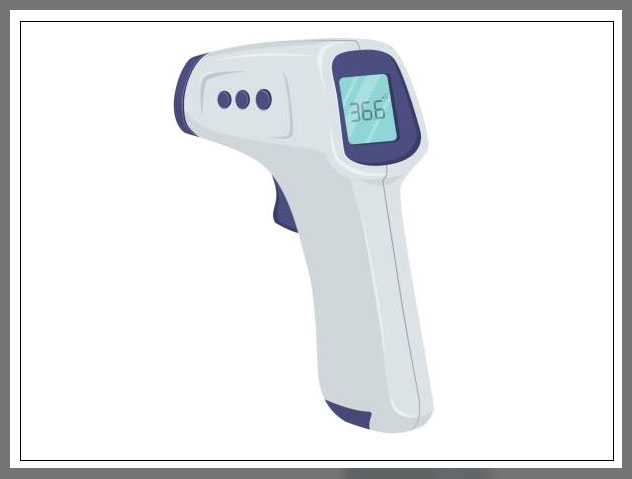
This type of thermometer is quick and easy to use.
Furthermore, a non-contact infrared thermometer often works by holding the thermometer wand an inch or two from the forehead of the patient and pressing a button to display two red circles of light on the forehead.
You will then move the thermometer closer to or farther from the forehead until the two red circles converge into one red circle.
Release the button, at which point the device will display the temperature.
In case your child is restless, it can be difficult to get an accurate temperature.
Also, different thermometers have an audible beep or other signal indicating that that reading is complete.
This means that you will not need to keep checking your watch.
Conclusion
A thermometer is an important part of any medical healthcare facility. With changing dynamics and the spread of diseases like COVID-19, many healthcare facilities today need to make use of digital thermometers.
These can help stop contamination of the device, which in turn helps to stop the spread of infection. Factors like ease of use, the temperature range, your budget, versatility, and unit of measurement can help decide which device is best to use.


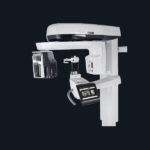
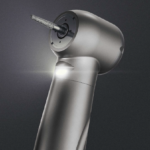
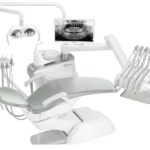
Comments